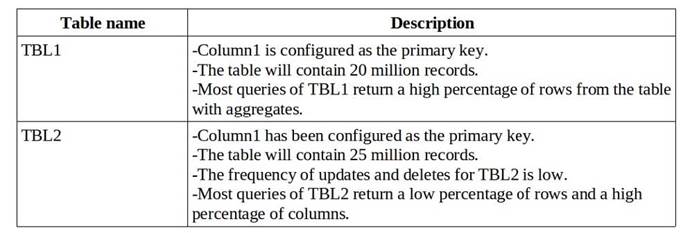Note: This question is part of a series of questions that use the same or similar answer choices. Ananswer choice may be correct for more than one question in the series. Each question isindependent of the other questions in this series.
Information and details provided in a question apply only to that question.
You have a Microsoft SQL Server database named DB1 that contains the following tables:

There are no foreign key relationships between TBL1 and TBL2.
You need to create a query that includes data from both tables and minimizes the amount of time required for the query to return data.
What should you do?
A . Create clustered indexes on TBL1 and TBL2.
B . Create a clustered index on TBL1. Create a nonclustered index on TBL2 and add the most frequently queried column as included columns.
C . Create a nonclustered index on TBL2 only.
D . Create UNIQUE constraints on both TBL1 and TBL2. Create a partitioned view that combines columns from TBL1 and TBL2.
E . Drop existing indexes on TBL1 and then create a clustered columnstore index. Create a nonclustered columnstore index on TBL1.Create a nonclustered index on TBL2.
F . Drop existing indexes on TBL1 and then create a clustered columnstore index. Create a nonclustered columnstore index on TBL1.Make no changes to TBL2.
G . Create CHECK constraints on both TBL1 and TBL2. Create a partitioned view that combines columns from TBL1 and TBL2.
H . Create an indexed view that combines columns from TBL1 and TBL2.
Answer: G
Explanation:
A partitioned view is a view defined by a UNION ALL of member tables structured in the same way, but stored separately as multiple tables in either the same instance of SQL Server or in a group of autonomous instances of SQL Server servers, called federated database servers.
Conditions for Creating Partitioned Views Include: The select list
![]()
All columns in the member tables should be selected in the column list of the view definition.
The columns in the same ordinal position of each select list should be of the same type, including collations. It is not sufficient for the columns to be implicitly convertible types, as is generally the case for UNION.
Also, at least one column (for example <col>) must appear in all the select lists in the same ordinal position. This <col> should be defined in a way that the member tables T1, …, Tn have CHECK constraints C1, …, Cn defined on <col>, respectively.
References:
https://docs.microsoft.com/en-us/sql/t-sql/statements/create-view-transact-sql

Leave a Reply